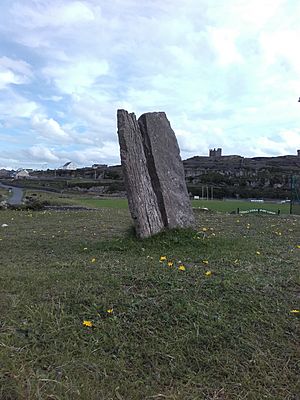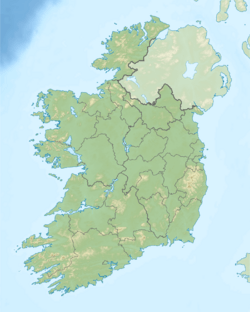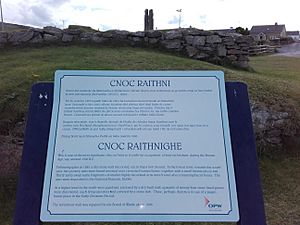Cnoc Raithní facts for kids

Slab atop Cnoc Raithní
|
|
| Alternative name | Knockgrannie, Knockgrannary, Cnoc Raithnighe |
|---|---|
| Location | Inisheer, County Galway, Ireland |
| Region | The Burren, Aran Islands |
| Coordinates | 53°03′54″N 9°31′24″W / 53.065019°N 9.523220°W |
| Type | tumulus |
| Area | 350 m2 (0.086 acres) |
| Diameter | 21 m (69 ft) |
| Height | 1.5 m (4.9 ft) |
| History | |
| Material | earth, sand, limestone |
| Founded | c. 1500 BC |
| Periods | Atlantic Bronze Age |
| Site notes | |
| Ownership | Office of Public Works |
| Public access | yes |
| Designation | |
Cnoc Raithní (pronounced 'Knock Rath-nee') means "hill of bracken". Bracken is a type of fern. This site is an ancient tumulus, which is a fancy word for a burial mound. It's also a National Monument in Ireland. You can find Cnoc Raithní on Inisheer, one of the beautiful Aran Islands.
Where is Cnoc Raithní?
Cnoc Raithní is located on the northern side of Inisheer. It sits right above the island's harbour. This spot offers great views of the sea.
What is the History of Cnoc Raithní?
The oldest part of Cnoc Raithní dates back a very long time. It was built around 2000 to 1500 BC. This makes it the earliest known settlement on Inisheer. A settlement is a place where people lived.
Later, the upper part of the mound was added. This happened during the Early Christian period. That was between the 5th and 8th centuries AD.
For many years, sand covered the site. Then, a big storm in 1885 uncovered it. After the storm, archaeologists started to explore it. They found special pots called cinerary urns. These urns held ancient remains. They also found a bronze awl, which is a small, pointed tool.
What Does Cnoc Raithní Look Like?
Cnoc Raithní is a round mound made of sand. It has a wall around it made of drystone. This means the stones are fitted together without mortar.
On the south side, you can see about 27 slab-lined graves. These are ancient burial spots marked with stone slabs. The north side has a platform with two limestone pillars. This platform is edged with stones.



